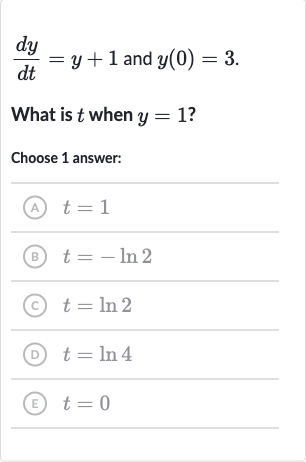AI tutor
Full solution
Q. What is when ?Choose answer:(A) (B) (C) (D) (E)
- Solve Differential Equation: First, we need to solve the differential equation with the initial condition . We can separate variables and integrate.
- Separate Variables: Separate the variables: = .
- Integrate Both Sides: Integrate both sides: .
- Find Constant of Integration: After integrating, we get , where is the constant of integration.
- Calculate C: Using the initial condition , we can find . Plug in and into to get .
- Obtain Particular Solution: Calculate : , so .
- Find for : Now we have the particular solution .
- Simplify Equation: We want to find when . Plug into to get .
- Subtract : Simplify the equation: .
- Combine Terms: Subtract from both sides to solve for : .
- Simplify Fraction: Use the property of logarithms to combine the terms: .
- Recognize : Simplify the fraction inside the logarithm: .
- Recognize : Simplify the fraction inside the logarithm: .Recognize that is the same as : .
More problems from Euler's method
QuestionGet tutor help
QuestionGet tutor help
QuestionGet tutor help
QuestionGet tutor help
QuestionGet tutor help
QuestionGet tutor help
QuestionGet tutor help
QuestionGet tutor help
QuestionGet tutor help

